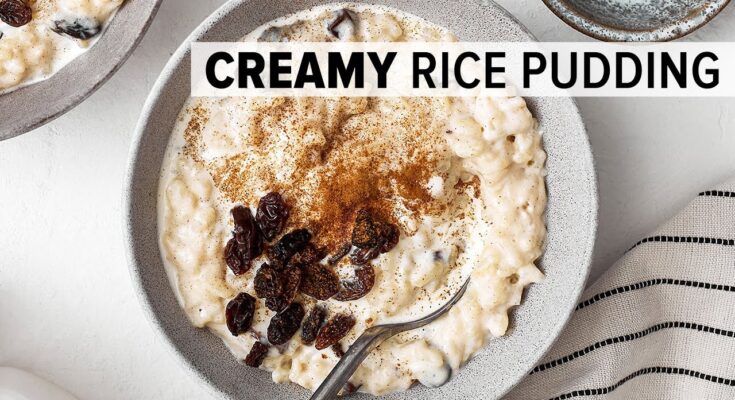Rice Pudding Recipe: Rice pudding is a creamy, comforting dessert enjoyed by many cultures around the world. Whether served warm or cold, this dish offers the perfect blend of soft rice, milk, and sugar, with subtle hints of spices like cinnamon and vanilla.
Rice pudding has roots in diverse cuisines—from the British version that includes nutmeg to the Middle Eastern roz bel laban and the Indian kheer. No matter where you’re from, this recipe offers an easy way to enjoy a classic comfort food that feels like a warm hug in a bowl.
So, why not give it a try? This step-by-step guide will walk you through the process of making perfect rice pudding at home, along with a few variations and troubleshooting tips to get it just right.
Ingredients Needed for Rice Pudding
Basic Ingredients
- Rice (Short-grain works best) – 1/2 cup
- Milk (Whole milk for creaminess) – 4 cups
- Sugar – 1/4 cup
- Salt – A pinch
- Vanilla extract – 1 teaspoon
Optional Add-Ons
- Cinnamon – 1 teaspoon
- Raisins – 1/2 cup
- Butter – 1 tablespoon for extra richness
Substitutes for Dietary Restrictions
- Use almond milk or oat milk for a vegan version.
- Swap sugar with maple syrup or honey for a natural sweetener.
Tools and Equipment You’ll Need
- Medium-sized saucepan
- Wooden spoon or spatula for stirring
- Measuring cups and spoons
- Bowl for pre-soaking the raisins (if using)
How to Make Rice Pudding from Scratch: Step-by-Step Guide
Step 1: Rinse the Rice
Start by rinsing the rice under cold water until the water runs clear. This removes excess starch, ensuring the pudding doesn’t become too sticky.
Step 2: Cook the Rice in Water or Milk
In a medium saucepan, combine the rice and 2 cups of water. Bring it to a boil over medium heat, then reduce the heat and let it simmer for 10-12 minutes until most of the water is absorbed. Alternatively, you can cook it directly in milk for a richer texture.
Step 3: Add Sugar and Flavorings
Once the rice is cooked, add the milk, sugar, and a pinch of salt. Stir well and bring the mixture to a gentle simmer. Add vanilla extract or cinnamon if you like.
Step 4: Simmer and Stir Constantly
Simmer the rice pudding on low heat for about 25-30 minutes. Stir frequently to prevent the rice from sticking to the bottom of the pan. The mixture will start to thicken gradually.
Step 5: Add Eggs or Thickeners (Optional)
If you prefer a custard-like texture, whisk one or two eggs in a separate bowl. Slowly add a few spoonfuls of hot pudding into the eggs to temper them, then stir the egg mixture back into the pudding.
Step 6: Adjust Consistency and Sweetness
Once the pudding has reached your desired thickness, taste it. If it’s not sweet enough, add a bit more sugar. If it’s too thick, stir in extra milk until the consistency is just right.
Different Ways to Serve Rice Pudding
Rice pudding can be enjoyed either warm or cold, depending on your preference. Top it with a sprinkle of cinnamon, fresh fruits, or a dollop of whipped cream to make it extra special.
Popular Flavor Variations
- Cinnamon and Raisin Rice Pudding: Add a teaspoon of cinnamon and pre-soaked raisins while the pudding simmers.
- Coconut Rice Pudding: Replace half the milk with coconut milk for a tropical twist.
- Chocolate Rice Pudding: Stir in cocoa powder or melted chocolate for a decadent dessert.
Storage and Leftover Tips
Rice pudding can be stored in the fridge for up to 4 days. If it becomes too thick, stir in a little milk before reheating. You can also freeze it for up to 2 months.
Health Benefits of Rice Pudding
Rice pudding provides a good amount of calcium and energy. Opting for whole grains or plant-based milk can make it even healthier.
Common Mistakes to Avoid
- Overcooking the Rice: Leads to mushy pudding.
- Not Stirring Regularly: May cause the pudding to stick or burn.
- Adding Too Much Sugar: Overpowers the delicate flavors.
Rice Pudding for Special Diets
- Vegan: Use plant-based milk and sweeteners.
- Gluten-Free: Naturally gluten-free, but double-check flavorings and toppings for hidden gluten sources.
Rice Pudding for Special Occasions
Rice pudding is perfect for holidays and cozy winter nights. Serve it with cranberries or orange zest during Christmas, or enjoy it warm during cold evenings.
Troubleshooting Your Rice Pudding
- Too Thick: Add more milk and stir well.
- Burnt Taste: Transfer to a new pot and stir in extra milk to salvage.
Rice Pudding vs. Other Desserts
Rice pudding is often compared to tapioca pudding and flan, but it offers a unique, creamy texture that’s hard to beat.
FAQs about Rice Pudding Recipe
What type of rice is best for making rice pudding?
For the creamiest texture, short-grain white rice, such as Arborio or sushi rice, is ideal. These varieties have a high starch content that helps thicken the pudding naturally as it cooks.
Can I use brown rice to make rice pudding?
Yes, you can use brown rice for a healthier alternative, though it has a chewier texture and requires a longer cooking time. Be sure to adjust the liquid quantities and cooking time accordingly.
Is rice pudding gluten-free?
Yes, rice pudding is naturally gluten-free as it primarily consists of rice, milk, and sugar. However, always check the labels of any additional ingredients like flavorings or toppings to ensure they do not contain gluten.
How can I flavor my rice pudding?
Classic flavorings include vanilla, cinnamon, and nutmeg. For a unique twist, try adding cardamom, coconut milk, or even a splash of rose water. Mix in raisins, dried cranberries, or chopped nuts for added texture.
Can rice pudding be made vegan?
Absolutely! Substitute the dairy milk with almond, coconut, or soy milk. Use a vegan sweetener like maple syrup or agave instead of honey or sugar if desired.
How long can I store rice pudding in the refrigerator?
Rice pudding can be stored in an airtight container in the refrigerator for up to 5 days. Ensure it is cooled completely before storing to maintain the best quality and safety.
Can rice pudding be frozen?
Yes, rice pudding can be frozen for up to 3 months. Place it in a freezer-safe container, leaving some space at the top as the pudding will expand when frozen. Thaw overnight in the refrigerator before reheating.
How do I reheat rice pudding?
Reheat rice pudding on the stove over low heat, adding a little milk or cream to loosen the texture. Stir continuously to prevent sticking. Alternatively, you can microwave it in short intervals, stirring in between to distribute the heat evenly.
Conclusion
Rice pudding is a simple yet satisfying dessert that anyone can master. With a few basic ingredients and some patience, you can create a delicious treat perfect for any occasion. Experiment with flavors and toppings to make it your own!
References
For further exploration and verification of the information provided in our Rice Pudding Recipe, the following references offer reliable and comprehensive insights:
- Joy of Cooking: This classic culinary guide provides extensive details on the variations and techniques of rice pudding. Accessible online and in libraries, it’s a treasure trove for both novice and seasoned cooks.
- Allrecipes.com: Featuring user-submitted recipes, Allrecipes offers a wide range of rice pudding recipes, each accompanied by community ratings and reviews. This resource is excellent for comparing different methods and ingredient choices.
- Food Network: Known for its expert chefs and diverse culinary content, Food Network provides both traditional and innovative rice pudding recipes that cater to all tastes. Their website includes step-by-step guides and video tutorials, which are great for visual learners.
- Epicurious: As a gathering spot for serious culinary enthusiasts, Epicurious offers detailed articles and recipes about rice pudding, including tips on achieving the perfect texture and flavor.
These sources are recommended for their credibility and variety, providing you with multiple perspectives and techniques to enhance your cooking experience.



